Codex Mendoza
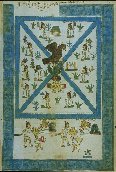 Also known as Codice Mendocino and La coleccion Mendoza is a
manuscript kept in the Bodleian Library at Oxford University. Although it
is a postcortesian document, made by request of Viceroy
Mendoza, but rendered by native scribes ("tlacuilos") shortly after the
conquest, it has the value and quality of any precolumbian manuscript.
Also known as Codice Mendocino and La coleccion Mendoza is a
manuscript kept in the Bodleian Library at Oxford University. Although it
is a postcortesian document, made by request of Viceroy
Mendoza, but rendered by native scribes ("tlacuilos") shortly after the
conquest, it has the value and quality of any precolumbian manuscript.
Viceroy Mendoza had it shipped to Spain in 1542, however, never made it to
its destination when the galleon carrying it fell in the hands of French
pirates. The manuscript was then consulted and autographed by the
cosmographer to King Francis I, André Thevet. Later on, it was
acquired by an English collector and then ended up in the
Bodleian Library at Oxford, its
current owner.
The Mendoza Codex is a complex document of historic, economic and
ethnographic value that was produced in Mexico City around 1541-42, on
European paper divided in three sections comprising 71 pages of 32.7 x
22.9 cm.
The diagrams of section I (pages 1-16) present the annals of the Tenocha
people, from the founding of the city of Tenochtitlan in 1325 until 1521,
going through every year, pointing out the timespan of each kingdom and
the town conquered by the Triple Alliance (Tenochtitlan-Tlatelolco-
Tacuba). The text in Spanish adds some supplementary information to
the ideograms.
The front page includes the quincunx displaying the four
boroughs of Tenochtitlan and also the rulers since the founding of
the city.
The glyph of the year of the dates were inscribed on the margin, against the
particular circumstance recorded. By means of small figures with their
glyphic names it is shown the rulers in each period, along with their
conquests. The conquered towns are represented by the glyph of a burned
temple, next to their glyphic name.
At the center of the quincunx, the codex shows the eagle perched on a
cactus, an emblem that would became part of the official seal and
of the Mexican flag.
The eagle is not shown devouring a snake in this codex, like the most common
version of the legend goes and as in other codices, such as the Aubin
Codex (1576), although its text does not mention the eagle.
Tezozomoc in the beginning of his well known Cronica
Mexicana (1598) mentions the eagle with the snake.

Section 2 of the Mendoza codex (pages 17-55) includes a roll of the
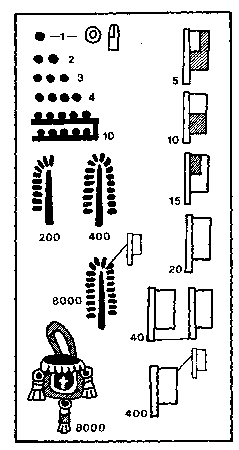 conquered towns
and the tributes paid by each one to the Triple Alliance, with a Spanish
interpretation. This sections helps in reading the glyphs for each town
as well as the ideograms used to represent numerals.
conquered towns
and the tributes paid by each one to the Triple Alliance, with a Spanish
interpretation. This sections helps in reading the glyphs for each town
as well as the ideograms used to represent numerals.
These numerals correspond to a vigesimal numeration (base 20),
characterized by the use of a figure resembling a finger to represent
a unit, or a circle, numeral twenty represented by a flag; the numbers
100, 200, 300 and 400 represented by a symbol resembling a feather,
and the number for 8000 represented by a purse or bag of incense.
Other numbers were represented by repeating these signs as often as
necessary, since the Nahoa numeration was based only on the additive principle
(i.e., no positional powers). To indicate twenty shields,
100 bags of cacao beans; or 200 jars of honey, for example, the
sign of 20 was reproduced once, five times, or ten times in
conjunction with the corresponding pictographs for the item involved.
The large set of objects tributed provides a glimpse of the main goods and
commodities used in preColumbian Mexico. There is a variety of attires,
feather headdresses, shields, cloths of several sizes and colors, blouses,
skirts, weapons of different types, bushels of corn, trinkets, beans, chia,
cocoa, incense and other produce, skins and live animals. There are also
crafts made of gold, silver, and copper.
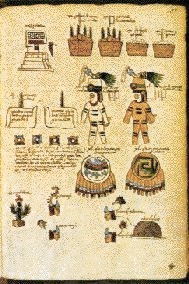
The tribute model operated according to the model displayed on the title
page: a metropolitan center surrounded by four provinces to the west,
south, east and north, each with its typical products and customs. The
overall number of towns subject to the capitals of these five regions
was made equal to the number of days in the year, just as the total
number of head towns in the quarters equalled the
number of nights in the lunar month.
| Gobernadores | Head Towns |
|
Petlacalcatl | +123 | Center | 9 |
|
Atotonilco | +46 | West | 7 |
|
Tlachco | +69 | South | 7 |
|
Chalco | +82 | East | 7 |
|
Cuauhtochco | +45 | North | 8 |
| 365 | 29 |
Section 3 of the codex (pages 55-71) is a graphical depiction of the
daily life of the
Aztecs
from infancy to death, probably made specially for the codex and has been
considered an early treatise on ethnography. It includes scenes showing
parents educating their children; and others showing the education of
youngsters in public schools ("tepochcalli"). Matrimony and wedding rituals
are also described in vivid colors. The artisans and craftsmen are included,
as well as the merchants ("pochteca") who travel to remote locations,
sailors in their boats, warriors who take captives, dignitaries, judges,
priests and other public servants like ambassadors, executioners of
punishments, and those who organize and run markets.
Education is a recurring theme, and the noble arts and professions are
discussed at length, singers, musicians, painters ("tlacuilo"), scribes and
artists. In contrasts, the manuscript also portrays those walks of life more
worthy of condemnation such as vagabonds, thieves, gamblers (including
ballgame players), gossips, drunkards, and prostitutes. The last page
includes the two vices held as the most nefarious. One is adultery, which
along with stealing, was punished with death. The other offense is
alcoholism, which was only excused in the elderly who were allowed to
drink as much as they would want.
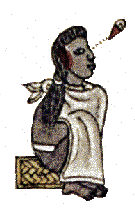
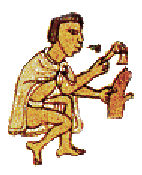
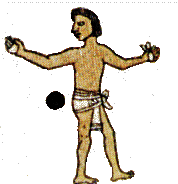
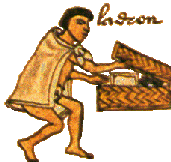
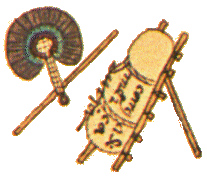
The Codex Mendoza has been used as a basis for the understanding of the
the Nahuatl culture and also represents a key for the study of more cryptic
manuscripts of the Central Valley of Mexico and the rest of Mesoamerica.

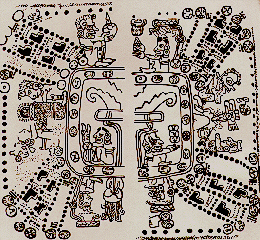
References
-
Berdan, Frances, Patricia Rieff Anawalt, Codex Mendoza, University
of California Press, 1992.
-
Berdan, Frances, Patricia Rieff Anawalt, The Essential Codex Mendoza, University of California Press, 1997.
-
Brotherston, Gordon, Painted Books from Mexico,
British Museum Press, 1995.
-
Burland, C.A., Magic Books from Mexico, King Penguin, 1953.
-
Clark, James Cooper (ed), Codex Mendoza, 3 vols., Waterlow &
Sons, London, 1938.
-
Echegaray, José Ignacio, (Ed.) Códice Mendocino o
colección Mendoza, preface by Ernesto de la Torre Villar,
San Angel Ediciones, México, 1979.
-
Escalona, Enrique, Tlacuilo (documentary film), CIESAS/UNAM,
Mexico, 1989.
-
Mohar Betancourt, Luz María, La escritura en el México
antiguo: La Matricula de Tributos y el códice Mendoza,
2 vols, México, Plaza y Valdés, 1990.
-
Nowotny, Karl A., Tlacuilolli: Die mexikanischen Bilderhands
chriften, Stil und Inhalt, Mann, Berlin, 1961.
-
Ross, Kurt, Codex Mendoza, Liber Productions, Fribourg, 1984.
 feedback to keeper
feedback to keeper
Copyright © 1996-2000 VMG
 Also known as Codice Mendocino and La coleccion Mendoza is a
manuscript kept in the Bodleian Library at Oxford University. Although it
is a postcortesian document, made by request of Viceroy
Mendoza, but rendered by native scribes ("tlacuilos") shortly after the
conquest, it has the value and quality of any precolumbian manuscript.
Also known as Codice Mendocino and La coleccion Mendoza is a
manuscript kept in the Bodleian Library at Oxford University. Although it
is a postcortesian document, made by request of Viceroy
Mendoza, but rendered by native scribes ("tlacuilos") shortly after the
conquest, it has the value and quality of any precolumbian manuscript.

 conquered towns
and the tributes paid by each one to the Triple Alliance, with a Spanish
interpretation. This sections helps in reading the glyphs for each town
as well as the ideograms used to represent numerals.
conquered towns
and the tributes paid by each one to the Triple Alliance, with a Spanish
interpretation. This sections helps in reading the glyphs for each town
as well as the ideograms used to represent numerals.








 feedback to keeper
feedback to keeper